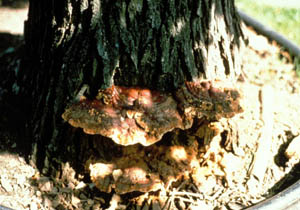Wood-Rotting Fungi | |
|---|---|
| October 22, 2008 | |
|
There are many fungi that cause decay of wood in trees; and it can be a frustrating task to try to identify one of over 500 species that might be involved. Nearly 2 years ago, I listened to a presentation by Christopher Luly at the Illinois Arborists Association annual meeting. Dr. Luly discussed wood-rotting fungi and helped simplify the identification process for me. If you work in the area of tree health, I strongly recommend you get a copy of Dr. Lulyís book, Wood Decay Fungi Common to Urban Living Trees in the Northeast and Central United States. I bought mine through the Illinois Arborists Association, but you can probably order it with the ISBN #0-9767129-1-1, printed by Urban Forestry LLC in 2005. It is only 58 pages long, and there are many pictures. Wood decay is caused by fungi. The major group of fungi involved is the basidiomycete group. There are also a significant number of ascomycete fungi that could be involved. These terms might not mean much to you, but the fruiting structures of these fungi on living trees are what we look at to help confirm the identity of the pathogen and help estimate the amount of decay. The mushrooms, conks, or other fruiting structures still attached to living but damaged trees give us the facts to make an identification of the fungus. Once we know the fungus involved, we can determine whether the rot is expected to affect roots, trunk or branches, sapwood or heartwood, and sometimes even the amount of decay. Of course, fruiting structures are not always present, but this book is helpful in cases where fruiting structures are found. Dr. Lulyís book presents a photo key to help separate the common tree decay fungi. He addresses the major urban wood rot fungi in detail, listing habitat, fruiting time of year, type of decay, mode of action of the fungus, and tree health symptoms. Here are two examples of wood rot fungi you could identify with this book. The images here show two common wood rot fungi that have appeared at the Plant Clinic at the University of Illinois. The black, fingerlike structures  are from the base of my dying redbud tree. The tree had three trunks that slowly spread out with time and became infected with canker fungi. This fungus is a Xylaria species, better known as dead manís fingers, a common wood rot fungus. The fungus fruits from summer through fall. In Dr. Lulyís book, it states that this fungus causes soft, butt, and root rot, which was certainly the case on my tree. It is listed as a weak pathogen with slow decay. That too was the case. The second image is more typical of another type of fruiting body called conks, shelf fungi, bracket fungi, or similar names. This one is from honeylocust. It is growing out of the trunk of a living tree.  This conk is found attached to the base of the tree or to roots. The fungus causes white rot of the roots and butt of the tree. Dr. Luly lists this as a moderately fast-progressing root and butt rot and adds that the fungus can kill cambial tissue and kill roots. It is not difficult to understand how it killed many of the honeylocust on the University of Illinois campus in a few years. Take a look at this book when you get a chance. I know it will help you in your tree care work. | |
| Author: | Nancy Pataky |
